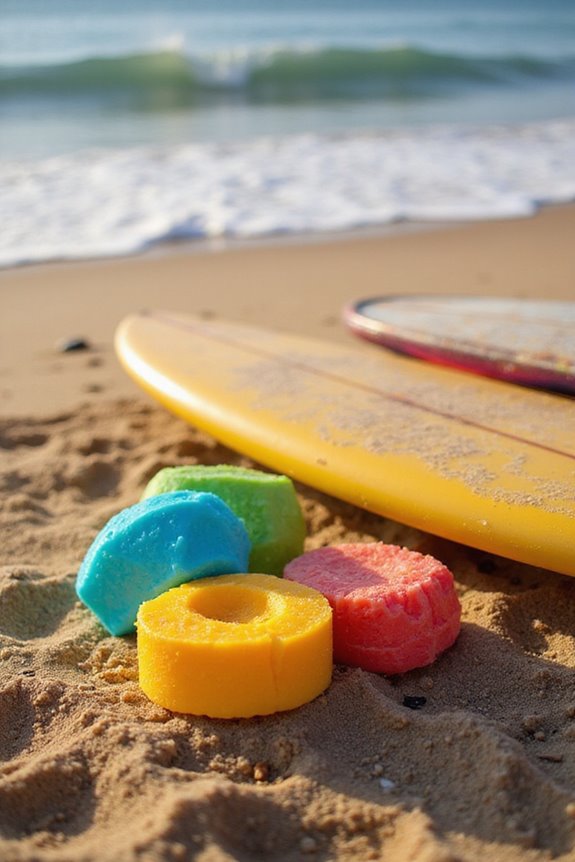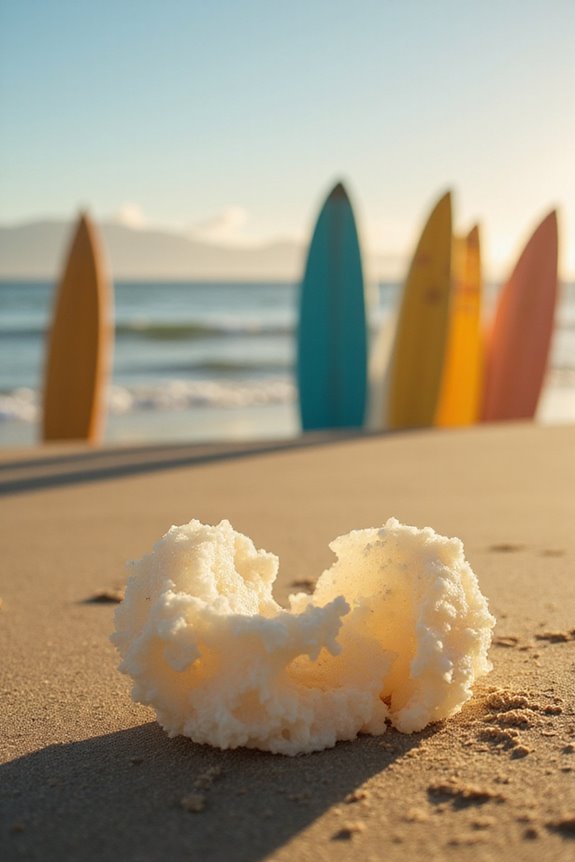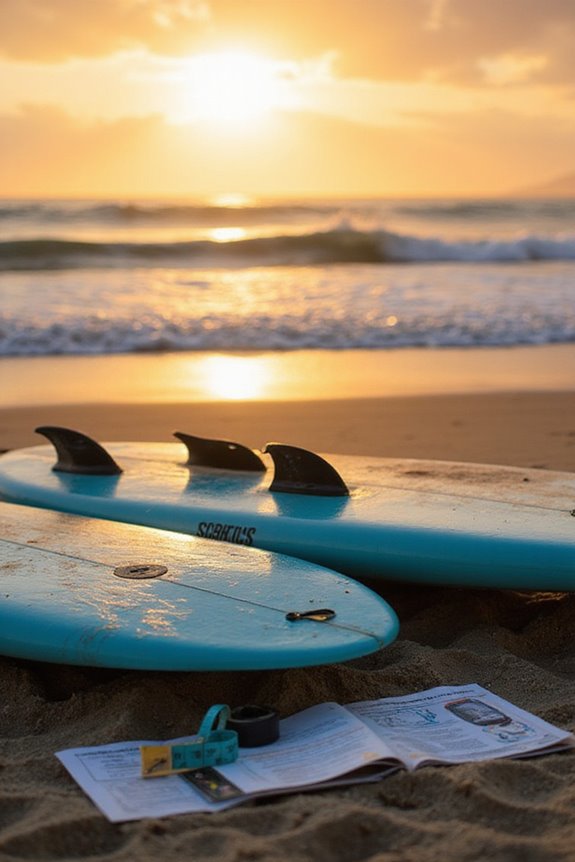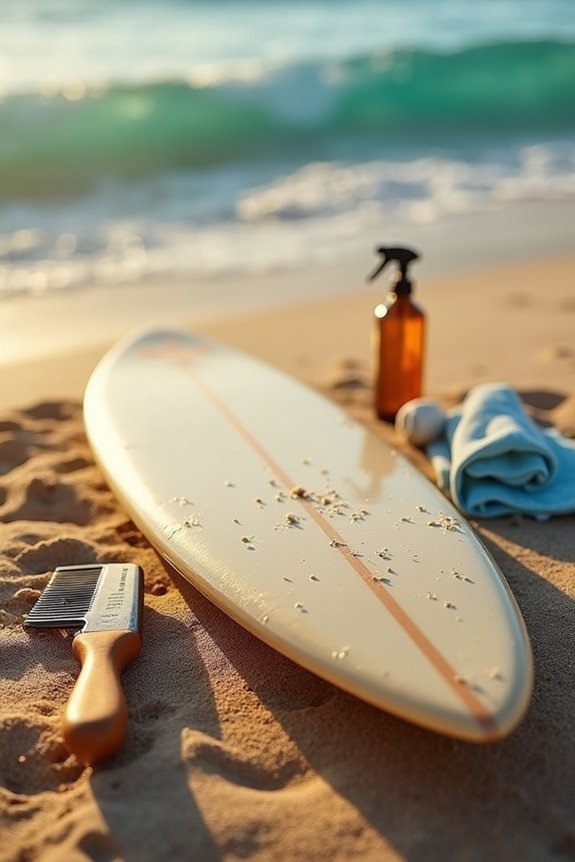Surf wax is essential for creating a non-slip surface on our surfboards, which helps with balance and control while riding waves. Typically made from natural ingredients like beeswax, coconut oil, and pine rosin, it provides the grip needed during paddling and maneuvers. We use different types for various water temperatures, with base coats for hardness and top coats for grip. Understanding surf wax can enhance our surfing experience and improve performance on the water.
Key Takeaways
- Surf wax is a specialized product that creates a non-slip surface on a surfboard for improved grip and control while surfing.
- It is made from various natural and synthetic ingredients, including beeswax, coconut oil, and paraffin wax, to enhance performance.
- Surf wax comes in different formulations, including base coat for hardness and top coat for softer grip, tailored for specific water temperatures.
- Frequent reapplication is necessary, as surf wax wears off due to water exposure and debris, ensuring optimal performance during use.
- Eco-friendly alternatives are available, made from biodegradable materials, reducing environmental impact and promoting sustainable surfing practices.
Composition and Ingredients of Surf Wax
When we look at surf wax, it’s crucial to understand its composition and ingredients, as they directly influence its performance on the water. The ingredient variations can include natural bases like beeswax, coconut oil, and soy wax, which provide hardness, pliability, and environmental benefits. Paraffin wax, often used for its hardness, and mineral waxes enhance texture and flexibility.
Additionally, tackifying agents such as pine rosin guarantee grip on the surfboard. Oils like castor oil and coconut oil improve pliability and scent. Synthetic components, including microcrystalline wax and petroleum jelly, can be added to adjust stickiness and performance. Understanding these wax properties helps us choose the right surf wax for peak performance based on conditions. Moreover, many organic surf waxes are made from renewable ingredients, highlighting their commitment to environmental sustainability.
Purpose and Usage of Surf Wax
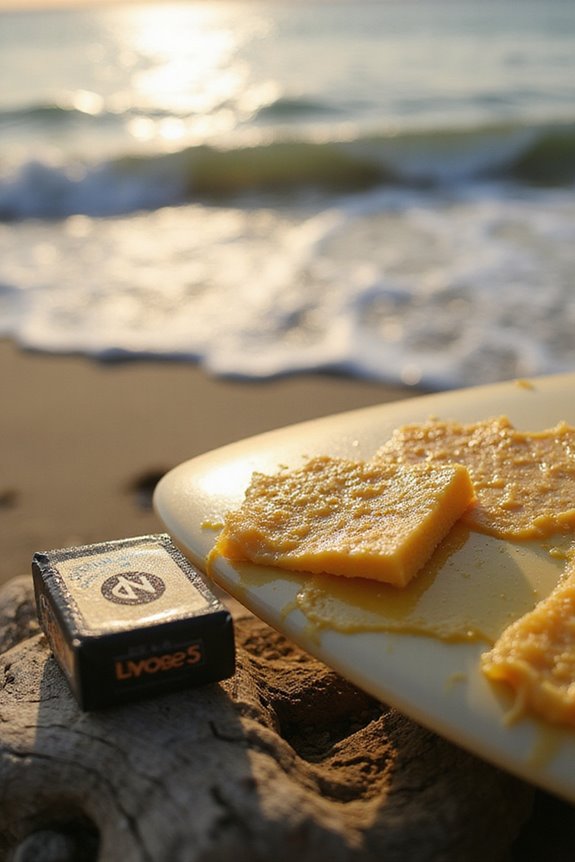
Surf wax serves multiple essential purposes for surfers, enhancing both safety and performance on the water. It creates a non-slip surface on the deck of the surfboard, allowing us to plant our feet firmly, which aids in balance and control. This stability is fundamental during paddling, popping up, and executing maneuvers.
Proper application techniques are critical for maximizing grip, requiring an even coating tailored to water temperature. We must reapply wax frequently to maintain its durability, as exposure to water and debris diminishes its effectiveness. By ensuring a secure footing, surf wax not only reduces the risk of falls but also builds our confidence to tackle challenging waves, making it an indispensable part of our surfing routine. Additionally, using temperature-specific wax can significantly enhance performance based on the conditions you encounter.
Types and Formulations of Surf Wax
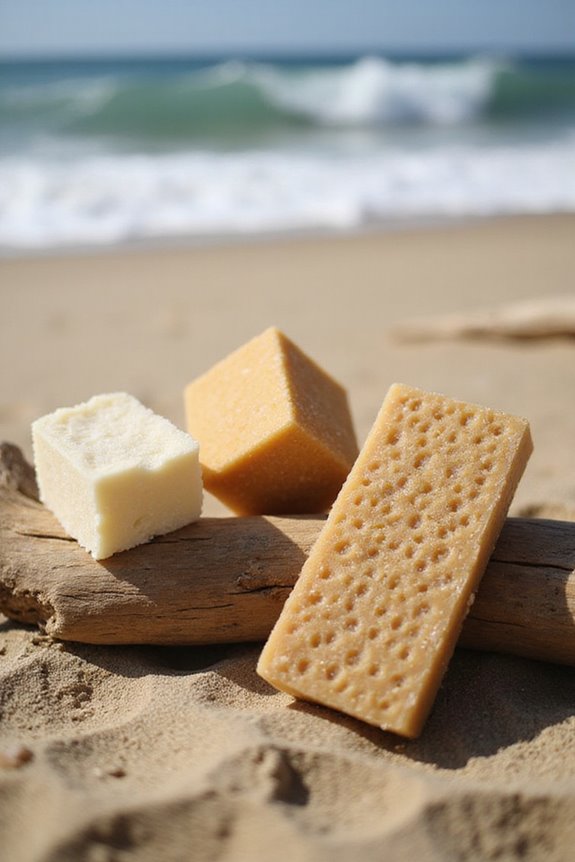
Understanding the different types and formulations of surf wax is essential for optimizing our surfing experience. There are primarily two types: base coat and top coat. The base coat is harder and provides a stable foundation, while the softer top coat enhances grip.
Waxes are temperature specific, with cold water wax being the softest for water below 58°F, and tropical wax being the hardest for temperatures above 75°F.
Additionally, we can choose eco-friendly options made from soy or beeswax, which vary in hardness and biodegradability. Finally, many waxes come with sensory variations like added fragrances, enhancing our overall experience without changing functionality. Understanding these options helps us select the right wax for our needs. Moreover, many high-performance waxes, such as base coat waxes, are designed for optimal grip and durability across various conditions.
Environmental and Ethical Considerations
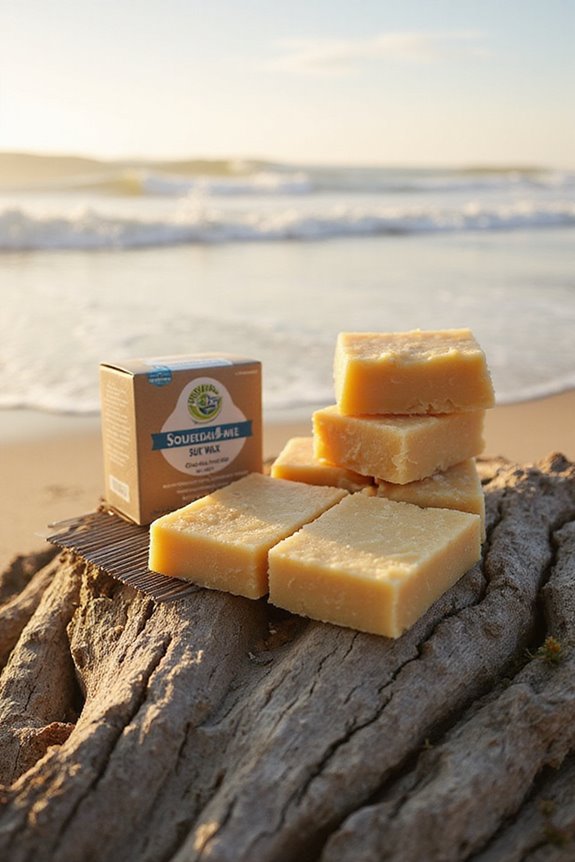
As we consider our impact on the environment, it is crucial to examine the ethical implications of using traditional surf wax. Most surf waxes are made from petroleum, contributing to fossil fuel dependency and microplastic pollution. Every year, the surf community generates significant waste, with around 86 tons of wax entering our oceans.
To promote sustainable practices, we should explore eco-friendly alternatives. Brands are developing biodegradable surf waxes that use plant-based ingredients, reducing our ecological footprint. Ethical surfing movements encourage us to make responsible choices, from the wax we use to the boards we ride. By shifting towards sustainable options, we can protect marine ecosystems and create a healthier future for our oceans and ourselves. Additionally, opting for reef-safe options can further minimize our impact on marine life while enjoying our time in the water.
Removal and Maintenance of Surf Wax
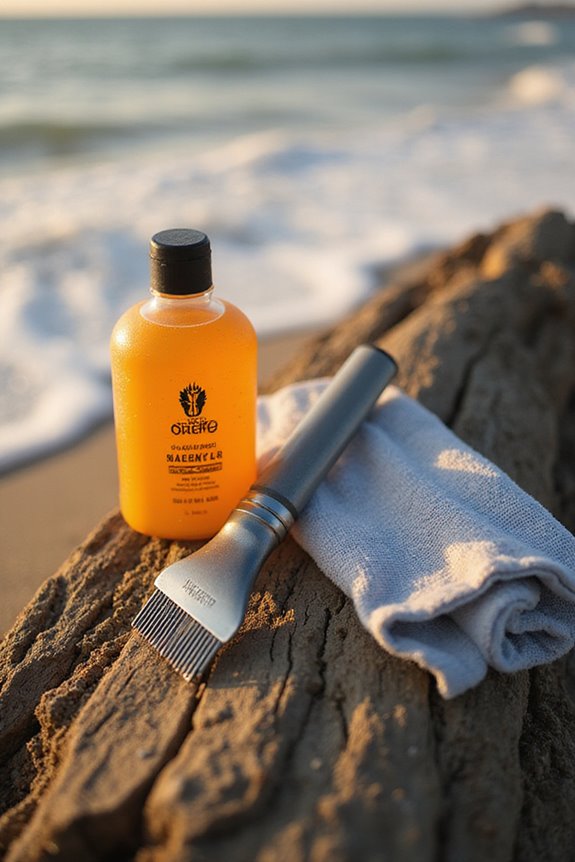
When we think about maintaining our surfboards, the removal and upkeep of surf wax play an essential role in guaranteeing ideal performance. To effectively remove wax, we can use various wax removal techniques, such as sun heating, scraping with a wax comb, and employing a stiff plastic scraper for residues.
Here are some maintenance tips to take into account:
- Let the board sit in the sun for 5 to 15 minutes to soften wax.
- Use a wax comb to scrape gently, avoiding damage.
- Wipe the board with a soft cloth to eliminate residue.
- Apply a thin base coat before a top coat to enhance adherence.
- Store boards away from direct sunlight to preserve wax integrity.
- Consider using non-staining formulas to ensure a mess-free cleaning experience.
Regular removal guarantees optimal grip and riding experience.
Popular Brands and Products
Surf wax is an essential component for any surfer, as it greatly impacts our grip and overall performance on the waves. Understanding the surf wax history helps us appreciate the evolution of popular brands like Sticky Bumps, known for its reliable traction and durability. Mr. Zog’s Sex Wax, an iconic choice since 1972, offers temperature-specific formulas and a distinctive coconut scent that resonates with many surfers.
Other notable brands include Fu Wax, which focuses on eco-friendly ingredients, and FCS Surf Wax, known for its smooth application. Lastly, Bear Foot Surf Wax is gaining popularity for its strong grip and competitive pricing. Overall, brand comparisons reveal a diverse range of options tailored to various surfing styles and preferences. Additionally, the right surf wax can enhance stability and maneuverability, crucial for improving your performance on the waves.
DIY Surf Wax Recipes
Creating our own surf wax can be a rewarding experience, allowing us to customize the formula to match our surfing conditions. We can start with basic homemade recipes using beeswax and coconut oil, mixing about three parts beeswax to one part coconut oil for warmer water. For cooler conditions, adding tree resin increases tackiness.
Preparation Steps:
- Melt beeswax gently at 100°F.
- Warm coconut oil separately, then blend into melted beeswax.
- Stir continuously for an even texture.
- Pour into molds and let solidify.
Tips for Surfboard Care:
- Adjust ratios for desired stickiness and melting point.
- Keep it eco-friendly by using natural ingredients.
Experimentation helps us find the best balance for our specific surf environments.
Frequently Asked Questions
How Long Does Surf Wax Typically Last on a Board?
We’ve noticed that wax durability varies greatly; it can last from a few sessions to weeks. Proper board maintenance, like checking and renewing often, helps extend wax life and keeps our grip reliable.
Can I Mix Different Types of Surf Wax?
Ever thought about mixing surf wax types? We can experiment with different surf wax, but mixing them can lead to unpredictable results. Let’s be cautious—too soft or too hard might ruin our ride!
Does Surf Wax Expire or Go Bad?
We’ve noticed that surf wax doesn’t technically expire, but we should watch for expiration signs like texture changes. Proper wax storage away from heat and sunlight helps maintain its effectiveness for longer rides.
How Often Should I Reapply Surf Wax?
Did you know daily surfers should reapply wax before each session? We’ve found effective application techniques like crisscross patterns enhance grip, while regular wax removal prevents buildup, ensuring peak performance on the waves.
Can Surf Wax Be Used on Other Sports Equipment?
While surf wax can enhance surfboard grip, it’s not ideal for other sports equipment. We should consider wax alternatives like traction pads for better performance and less mess on non-water surfaces.

